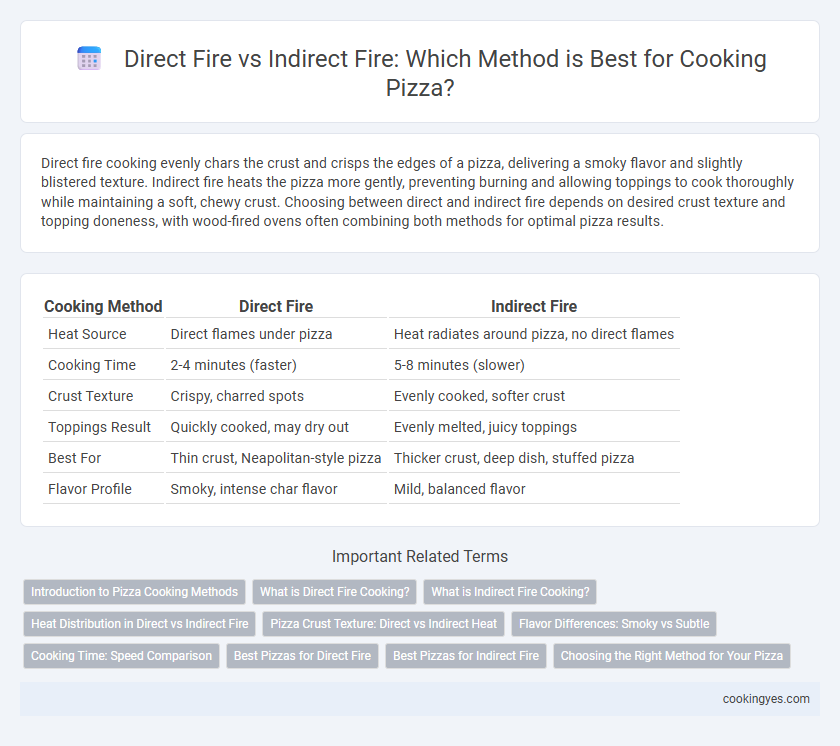Direct fire cooking evenly chars the crust and crisps the edges of a pizza, delivering a smoky flavor and slightly blistered texture. Indirect fire heats the pizza more gently, preventing burning and allowing toppings to cook thoroughly while maintaining a soft, chewy crust. Choosing between direct and indirect fire depends on desired crust texture and topping doneness, with wood-fired ovens often combining both methods for optimal pizza results.
Table of Comparison
| Cooking Method | Direct Fire | Indirect Fire |
|---|---|---|
| Heat Source | Direct flames under pizza | Heat radiates around pizza, no direct flames |
| Cooking Time | 2-4 minutes (faster) | 5-8 minutes (slower) |
| Crust Texture | Crispy, charred spots | Evenly cooked, softer crust |
| Toppings Result | Quickly cooked, may dry out | Evenly melted, juicy toppings |
| Best For | Thin crust, Neapolitan-style pizza | Thicker crust, deep dish, stuffed pizza |
| Flavor Profile | Smoky, intense char flavor | Mild, balanced flavor |
Introduction to Pizza Cooking Methods
Direct fire pizza cooking involves placing the pizza directly over an open flame or hot coals, resulting in a crispy crust and quick cooking times, typically between 60-90 seconds at temperatures of 700degF to 900degF. Indirect fire cooking uses heat radiated from a covered grill or oven, allowing for more even cooking at lower temperatures, generally around 400degF to 500degF, which enhances the development of toppings and a chewier crust. Skilled pizzaiolos choose between these methods based on desired texture, crust thickness, and cooking environment.
What is Direct Fire Cooking?
Direct fire cooking involves placing the pizza directly over or very close to an open flame, resulting in intense heat that quickly crisps the crust and chars the toppings, creating a smoky, flavorful profile. This method, often used in wood-fired ovens or on grill grates, can reach temperatures above 900degF, enabling pizzas to cook in as little as 90 seconds. The high heat from direct fire caramelizes sugars in the dough and toppings, delivering the signature texture and taste prized in traditional Neapolitan-style pizzas.
What is Indirect Fire Cooking?
Indirect fire cooking for pizza involves placing the pizza away from the direct heat source, often using a wood-fired oven or gas grill where the flames do not touch the pizza directly. This method allows even heat circulation, producing a crisp crust and thoroughly cooked toppings without burning. Pizza baked with indirect fire benefits from consistent heat and enhanced flavor development through slow, controlled cooking.
Heat Distribution in Direct vs Indirect Fire
Direct fire delivers intense, concentrated heat that sears the pizza crust quickly, creating a crisp exterior and characteristic char. Indirect fire provides more even heat distribution by circulating hot air around the pizza, resulting in a uniformly cooked crust and toppings without burning. Understanding the differences in heat distribution allows pizza makers to control texture and flavor profiles more precisely based on desired results.
Pizza Crust Texture: Direct vs Indirect Heat
Direct fire cooking exposes pizza dough to intense, radiant heat that creates a crispy, charred crust with a smoky flavor and a chewy interior. Indirect fire heats the pizza more evenly and slowly, resulting in a softer crust with a uniform rise and less charring, preserving moisture within the dough. The choice between direct and indirect heat affects crust texture significantly, with direct heat favored for traditional, Neapolitan-style pizzas and indirect heat preferred for thicker, pan-style crusts.
Flavor Differences: Smoky vs Subtle
Direct fire cooking infuses pizza with a bold, smoky flavor due to intense heat and open flame exposure, creating crispy crusts and charred toppings. Indirect fire cooking produces a subtler, more balanced flavor profile by using radiant heat, preserving delicate ingredient nuances without overwhelming smokiness. The choice between direct and indirect fire significantly impacts the overall taste experience, catering to preferences for either robust smokiness or gentle, nuanced flavors.
Cooking Time: Speed Comparison
Direct fire pizza cooking typically yields faster results, with pizzas often ready in 90 seconds to 3 minutes due to intense, focused heat. Indirect fire methods generally require longer cooking times, ranging from 5 to 10 minutes, as heat surrounds the pizza more evenly but less intensely. The rapid cooking time of direct fire contributes to a crispier crust and charred toppings, preferred in traditional Neapolitan-style pizzas.
Best Pizzas for Direct Fire
Direct fire cooking uses intense, direct heat from flames, creating an ideal environment for Neapolitan and wood-fired pizzas that require high temperatures and quick cooking times. This method achieves a crispy, charred crust with a smoky flavor, perfect for thin, artisanal pizzas topped with fresh ingredients. Pizzas with simple toppings like Margherita or pepperoni excel under direct fire due to their need for rapid baking to retain freshness and texture.
Best Pizzas for Indirect Fire
Indirect fire excels at cooking thick-crust and stuffed pizzas by providing even, consistent heat that prevents burning while ensuring the dough cooks through. Pizzas with heavy toppings, such as deep-dish or pan-style varieties, benefit from lower, slower heat to maintain moisture and develop rich flavors. Using indirect fire allows the cheese to melt perfectly without overcooking the crust or toppings, ideal for achieving a balanced and delicious pizza experience.
Choosing the Right Method for Your Pizza
Direct fire cooking for pizza involves placing the pizza close to or over the flame, resulting in a crispy crust and charred spots that enhance flavor, ideal for Neapolitan-style pizzas. Indirect fire cooking uses heat from the sides or below without direct contact, creating an evenly cooked pizza with a softer crust, suitable for thicker or stuffed varieties. Selecting the right method depends on desired crust texture, pizza thickness, and cooking equipment available, balancing high-temperature searing with controlled heat distribution.
Direct Fire vs Indirect Fire for Pizza Cooking Infographic

 cookingyes.com
cookingyes.com